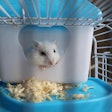Dietary histidine has been shown to elevate circulating free histidine and plasma histamine concentration in murine models as much as six-fold. Bladder mastocytosis is a hallmark of feline interstitial cystitis, and histidine is stored in mast cells and converted to histamine for signaling and inflammation by the enzyme histidine decarboxylase. Elevated dietary histidine may represent a risk factor for heightened mast cell responses.
Nine healthy adult female shorthair cats were used to test the effects of dietary histidine (0.6%, 1.0% and 1.4% on a dry matter basis, or DM) on histamine in blood and urine. They ate dry, extruded test foods in sufficient amounts to maintain ideal body weight. Each experimental period was preceded by a seven-day period of feeding the 0.6% histidine diet, followed by a 14-day feeding period of the appropriate test food.
DM intake was not affected by treatment. Plasma histidine concentration increased with dietary supply of histidine. Urine output and titratable acidity of urine were similar across treatments. However, urine pH was lower in cats fed 1.4% histidine compared with 0.6% or 1.0%. Urinary histamine:creatinine was greater for the 1.4% histidine treatment compared to other diets, while urinary histamine concentration and plasma histamine concentration were unaffected. No differences among treatments in total histamine, cellular + noncellular or antigen-induced histamine release were detected in whole blood.
Increase in dietary histidine elevates circulating concentrations of histamine or antigen-induced histamine release in whole blood, but urinary histamine excretion may be responsive to dietary histidine supply.
Source : S.K. Martin et al., 2012. Influence of dietary histidine on basophil release, circulating concentration and urinary excretion of histamine in domestic felines. Intern J Appl Res Vet Med 10: 289-299.

















